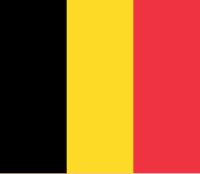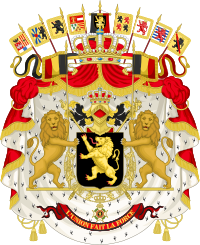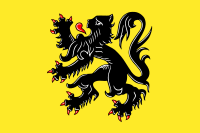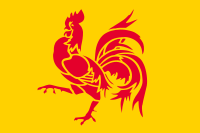
National symbols of Belgium are the symbols used to represent the Kingdom of Belgium. Article 193 of the Belgian Constitution is dedicated to specifying the national flag, colours, coat of arms, and motto. It says the following: "The Belgian nation takes red, yellow and black as colours, and as state coat of arms the Belgian lion with the motto Unity makes strength."[1]
YouTube Encyclopedic
-
1/5Views:1 1671 053 3223 4011 112 3872 405
-
Do You Know Belgium Basic Information | World Countries Information #17- General Knowledge & Quizzes
-
National Animals of all Countries
-
The National Bird of Every Country 🦚🦜| Official and Unofficial
-
National Fruits of Countries | Flags and countries name with National fruits
-
National animal of countries | National animals | Flags of the world
Transcription
National day
The national holiday of Belgium, Belgian National Day, is commemorated annually on 21 July,[2][3] but even though it is official, it is usually not considered a national symbol. The Flemish holiday is celebrated on 11 July,[3][4] the Walloon holiday is celebrated on the third Sunday in September,[3][5] the French-speaking Community's holiday is celebrated on 27 September, the German-speaking Community's holiday is celebrated on 5 November[3][6] and the Brussels holiday is celebrated on 8 May.[3]
Kingdom of Belgium
| Flag | Heraldry | Motto | Anthem |
|---|---|---|---|
| Flag of Belgium | Coat of arms of Belgium | Unity Makes Strength
Dutch: Eendracht Maakt Macht French: L'Union Fait La Force German: Einigkeit Macht Stark |
Brabançonne
|
Regions and Communities
| Brussels-Capital Region | Flemish Community | Flemish Region | French-speaking Community | Walloon Region | German-speaking Community | |
|---|---|---|---|---|---|---|
| Flag | Flag of the Brussels-Capital Region | Flag of Flanders | Flag of Wallonia | Flag of the German-speaking Community
| ||
| Heraldry | None | Coat of arms of Flanders | Coat of arms of Wallonia | Flag of the German-speaking Community | ||
| Anthem | None | De Vlaamse Leeuw
|
Le Chant des Wallons
|
None | ||
| Floral emblem | Yellow iris | Poppy | Gaillardia | Gentiana | ||
| Motto | None | None | French: Wallon toujours[7] | None | ||
| Animal | None | Lion | Rooster | None | ||
| Patron Saint | St. Michael | St. Ludgardis | None | None | ||
Unofficial symbols

The lion, especially the Leo Belgicus (Latin for "Belgian Lion") has been used as a heraldic animal to represent the Benelux for centuries. A heraldic lion can be seen on the Belgian coat of arms and can be seen as the countries de facto national animal. Moules-frites is often considered the unofficial national dish of Belgium.[8][9][10] The red poppy (papaver rhoeas) is often considered the national unofficial national flower of Belgium.[11][12][13] Other symbols of Belgium might include Manneken Pis, the Atomium, Belgian waffles, and Belgian fries, which were invented in Belgium.
-
Moules-frites
-
Red poppy
-
The Atomium
-
Brussels waffle
-
See also
References
- ^ "DE BELGISCHE GRONDWET". www.senate.be. Retrieved 2020-03-18.
- ^ "21 July: Belgium's National Day!". visit.brussels. Retrieved 2020-03-19.
- ^ a b c d e "Nationale Feestdag en feestdagen gemeenschappen en gewesten". Belgium.be (in Dutch). 2012-09-25. Retrieved 2020-03-19.
- ^ "Dossier: Vlaamse Symbolen". www.vlaamsparlement.be (in Flemish). Parlement Vlaams. Retrieved 2020-03-19.
- ^ "Symboles". Connaître la Wallonie. Retrieved 2020-03-19.
- ^ "Wappen und Fahne". www.ostbelgienlive.be. Retrieved 2020-03-19.
- ^ "Devise | Connaître la Wallonie". connaitrelawallonie.wallonie.be. Retrieved 2024-01-20.
- ^ Schaap, Esther (2018-04-30). "5 redenen om te kamperen in België". Suncamp holidays Blog (in Dutch). Retrieved 2020-03-18.
- ^ "L'origine des moules-frites". Léon de Bruxelles. Retrieved 2020-03-19.
- ^ Krause, Suzanne (2015-06-20). "Moules-Frites: Eine kleine Kulturgeschichte des belgischen Nationalgerichts". Deutschlandfunk (in German). Retrieved 2020-03-19.
- ^ "Blumen von Belgien – Roter Mohn". Tipps Gärtner (in German). Retrieved 2020-03-18.
- ^ "What Is The National Flower of Belgium?". WhatsAnswer. 2018-01-21. Retrieved 2020-03-19.
- ^ "National, Native and Popular Flower of Belgium". The Flower Expert. Retrieved 2020-03-19.





















